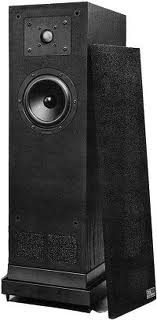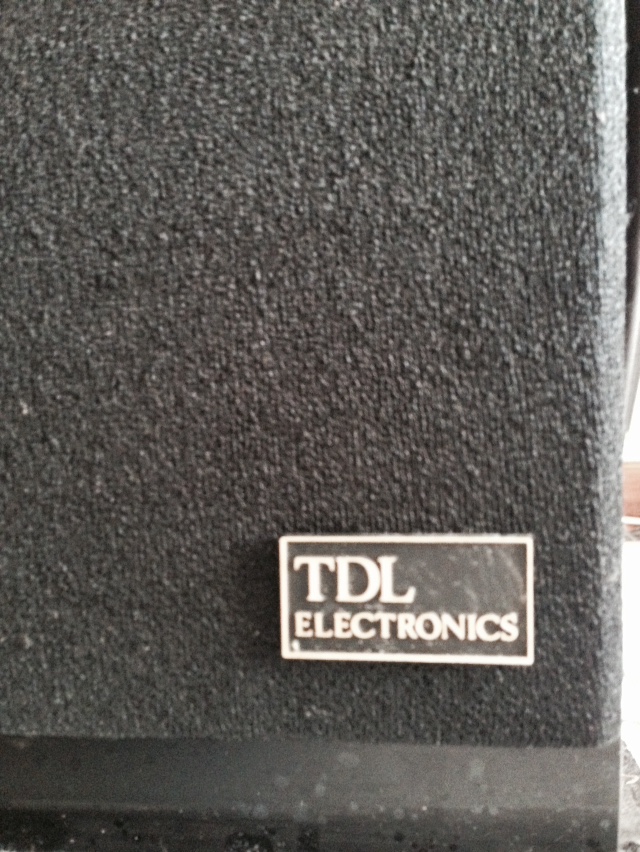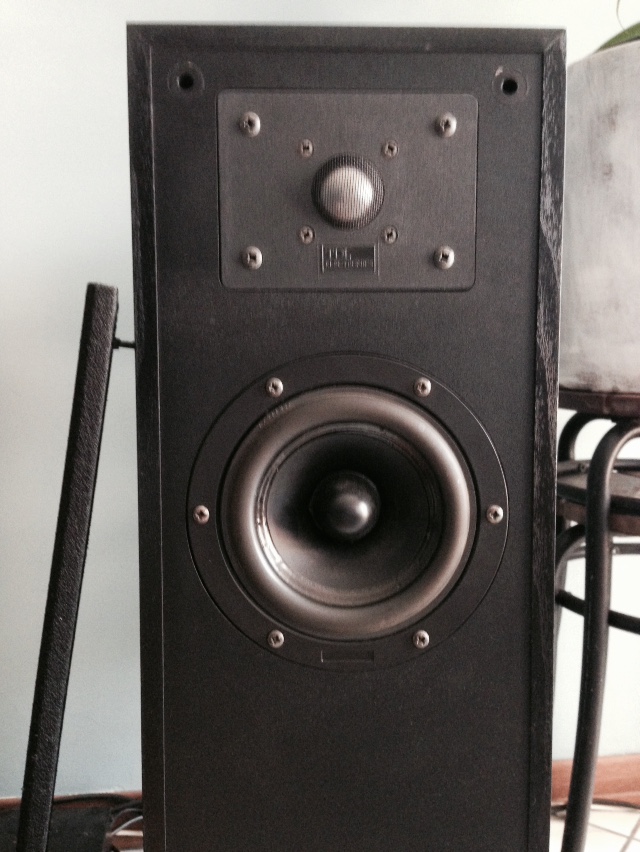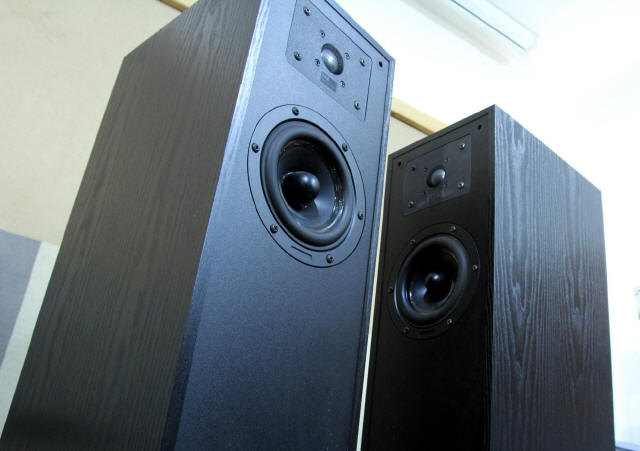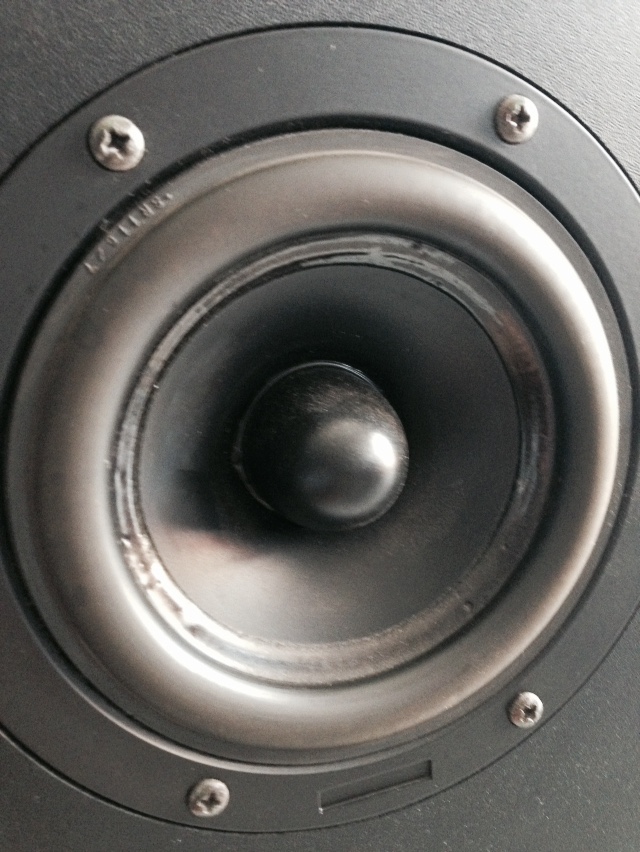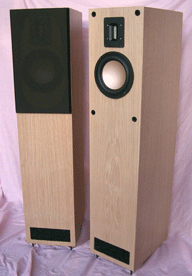My current system is centered around the loudspeakers, as it should always be since they are the component that affects the sound the most. Therefore it is a good rule of thumb to begin assembling a system by starting from the loudspeakers. I had decided for the Studio 0.5 (below) transmission line loudspeakers by TDL (Transducer Developments Limited) so I had to choose an amplifier that could do the job of driving them.
A transmission line is a labyrinth within the loudspeaker cases long enough to allow the woofer’s back emission to be synchronized to the front one so that the low range will be reinforced. A closed box (pneumatic suspension) can’t utilize the driver’s rear emission, so it will work down to the lowest frequencies at which it can vibrate, then their amplitude will gradually decrease and finally disappear (roll-off). This happens well before 20 Hz, which is the lower limit of the audible range (seldom present in many audio recordings), depending on the driver’s and even more form the box’s size. Normally, a tuning pipe is installed in some loudspeakers so to extend the low-frequency response of the system (bass reflex) in a way that depends on the size of the pipe. With this design the roll-off curve is steeper. In a transmission line system the woofer’s rear emission is channeled into the labyrinth (dampened with sound-absorbing material); the labyrinth’s length is 1/4 the woofer’s resonance wavelength. When the wave exits the labyrinth from an external window it is in phase with the front emission, therefore increasing the frequency range around the resonance frequency. But the roll-off here is as sweet as the closed box’s. Usually, such a design is rather complex, expensive and bulky, but the quality and the quantity of the bass range is incomparable to other technical solutions.
The system of my youth had been updated with an Onkyo amp and a JVC CD player, the latest innovation in budget digital technology sporting a 1-bit – or bitstream – conversion unit by Philips, the creator of the CD. My loudspeaker were DIY, something I had done with passion but lack of skill. They were certainly not up to the task. I was dreaming of buying new loudspeakers with the money I was gifted after my graduation. I ended up choosing the TDLs because I like the idea of a full-range system, where the loudspeakers can reproduce all audible frequencies at the same level. It might seem strange, but the lower range is usually dampened because of the small size of most loudspeakers on the market. Also, designing loudspeakers with an extended low range that would not affect the mid-highs is a rather complex task. Then I read about the transmission line technology; it was the best to keep the box size relatively small while achieving a good low-frequency response. Few manufacturers were capable of this. TDL was one of them.
TDL was born in the 70′ from the merger of IMF Electronics and the Electro Acoustic Industries (ELAC). The former was already famous for their transmission line loudspeakers, widely acclaimed but a niche of their own; the latter was then the leader of the British drivers market. TDL was based in High Wycomb, Buckinghamshire, and was well known for the great low frequency performance of their products. TDL’s strength came from the designer John Wright, who became the owner when ELAC called themselves out. By the end of the 90s, Wright was forced to quit for health reasons leaving his position to Julian Richer. Today TDL no longer exists, which would make it a problem to find ELAC replacement parts for these speakers.
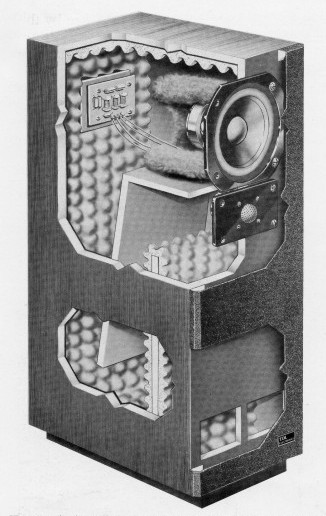
During the 90s I was an avid HiFi magazines reader. I fell in love with the TDL Studio 1 (above) after reading a review. It was the smallest transmission line loudspeaker on the market. According to the reviewer, their sound quality was embarrassing even to much expensive loudspeakers. They were almost talking about a miracle. I was already convinced a good system should finely reproduce the whole audible range from 20 to 20000 Hz. Let’s be clear: few musical instruments such as piano, double bass and pipe organ (plus bass drum and timpani), can go under 30 Hz (and by a tiny extent). Anyway, I still didn’t understand why people preferred small loudspeakers, that hardly extended below 60 Hz at an acceptable sound level. Yet, they were times when detail, meticulousness, definition of the sound reproduction were highly sought after; the belief was that an extended low range could disturb the mid-high range. I don’t understand why, provided the project is well designed. Maybe the only way to obtain those quality levels was a transmission line project, complex, hard to keep small and seldom cheap. It appears TDL did it: in fact, what struck me first in the Studio 1 review was their low frequency response, down to the 20 Hz audible boundary! Although 20 Hz do not even exist in musical recordings and live performances, a wide frequency range allows a complete reproduction of the audio information. You can certainly have full bass response, but it depends on the size of the listening room. Those two British technical jewels had then a listed price of 2.2 million lire, fairly low for their incredible performance, but unaffordable for me. They were certainly more than my system deserved, but this made me realize I really had to update my loudspeakers.
While I was meditating about my possibilities, in May 1991, the little sisters of the Studio 1 were also reviewed: the TDL Studio 0.5, transmission line minitowers with a deep and natural low range never experienced before from loudspeakers of that size: 62 cm stands excluded, yet floorstaning, just a 135 mm kapton woofer. They too could make competitors pale in embarrassment, although they went down to “only” 30 Hz. Maybe it is a “smarter” low range boundary since at least some real musical instruments rarely extend to those frequencies. But the point is not the mere ability to reproduce 30 Hz, which has no practical sense. The point is the exceptional quality of the project, allowing such a small loudspeaker to reproduce such a top-quality low range! Let’s be clear: 30 Hz are “useless” if not dangerous for the woofers beyond a certain decibel level (live performance loudspeakers are required to have high pass filters cut at 30 Hz). The thing is that the TDL’s 40 or 60 Hz ridicule(ed?) the 40-60 Hz of other kind of loudspeaker systems (let’s keep in mind that the low range includes 2-300 Hz). The Studio 0.5’s sound was described as “full, powerful, complex, tonally credible. A small extraordinary loudspeaker dramatically above any competitor when playing back tracks with an important low range; their low range performance is way beyond any other system”. Their list price was 1.6 million. Maybe I could do it. But I needed funds! I was thinking about a keyboard I had recently bought for experimenting with computer sequencing. I created musical bases for playing guitar along, my main instrument. Being a guitar-, not keyboard-player, I would be better selling the keyboard I was using at 5% its capabilities in order to upgrade the loudspeakers. I started pondering about the chance of buying a pair of TDLs. I didn’t sleep that night…
The morning after I was resolved to have the TDLs! I rapidly sold the keyboard at the same purchase price I paid for it used (it was flying off the shelves) and I started my search for a hifi shop were I could listen to the acclaimed TDLs. They made it clear immediately: my small, though good Onkyo A-8200 could not drive transmission lines; their 86 dB sensitivity and 6 Ohm impedance made the TDLs a difficult beast to harness: the driving amp should have been capable of strong currents in order to make them sing. I needed a muscle amp, not particularly powerful but capable of the high peak currents required during the most demanding tracks. There were many British candidates for the job, but in the end an Italian wins: Unison Research Mood. Thanks to this refined integrated from December 1991 to April 2019, and to a Naim Nait after that, I’m enjoying the typical sound of a transmission line system. The bass is so deep that you really believe there is a subwoofer installed someplace. In the listening room I had at the time I could not certainly have heard the 30 Hz the Studio 0.5 were capable of: the lower frequency audible in a room depends on its size. According to Landi’s formula, we can perceive the 30 Hz in a room whose longest side equals the speed of sound (at 20°C) divided 2x 30 Hz, which is 343 m/s / 2×30 Hz = 5,7 m. Not easy to find such a spacious room in a normal apartment flat! Anyway, between 20 and 60 Hz you perceive it, not hear it. In my current listening room I can maybe get closer, but I can assure you the quality of my system’s low range does not compare (some Home Theater exaggerations with pumped up basses that make wall tremble are nonsense: High Fidelity is realism, a credible and enjoyable performance resembling live playback). We’re talking about quality, about feeling the double bass strings vibrating in your belly, about perceiving the bass drum right there between the two TDL, without losing any detail such as the musician’s fingers slipping on the string or the noise of a singer’s lips while she/he modulates the sounds, the air blowing out of a saxophone or the noise of a trumpet’s piston valves.
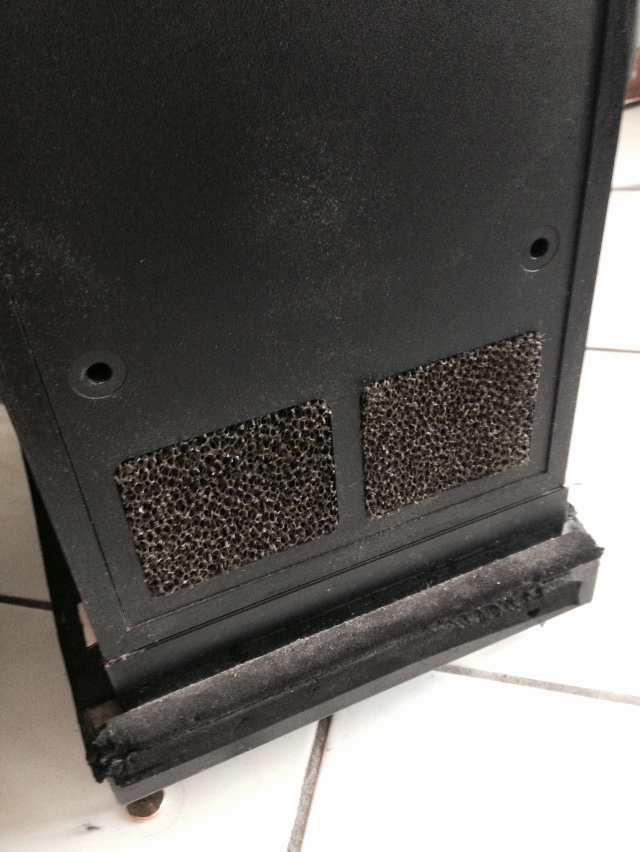
The double bass strings go down to 40 Hz and you feel that in your guts; only organ and big percussions go down to 28 Hz. The reviewer stated: “…it is hard to reproduce those frequencies with a different technique, especially if you don’t want the low range to spoil the mids and lose quality in the highs. Yet, the Studio 0.5 even tend to being bright, silky, lacking harshness in the highs, metal dome notwithstanding”. In fact the Studio 0.5’s tweeter “is a superb component, with a 25 mm magnesium, ferrofluid-cooled dome. It is a bit low standing with respect to a seated listener’s ears, so it is better to have the proper stands that can be tilted back by adjusting the spikes’ height, so that the drivers are oriented slightly upwards. This allows for an optimized stereo image and a wider soundstage. It takes a while to place them correctly, several tests, experimenting, patience; but once you find the correct placement you can enjoy an as wide a vertical soundstage as with much taller floorstaders, deeply extended both at the rear and beyond the sides of the loudspeakers. No problems in rendering the mid range (the crossover cuts at 3 KHz): they’re clean, defined, fluid and well analyzed; the performance with voices and bowed string instruments is beautiful. The low end is round, doughy, dense, solid, never harsh …what to say, you should listen to them, it is difficult to describe, well beyond their price tag…”
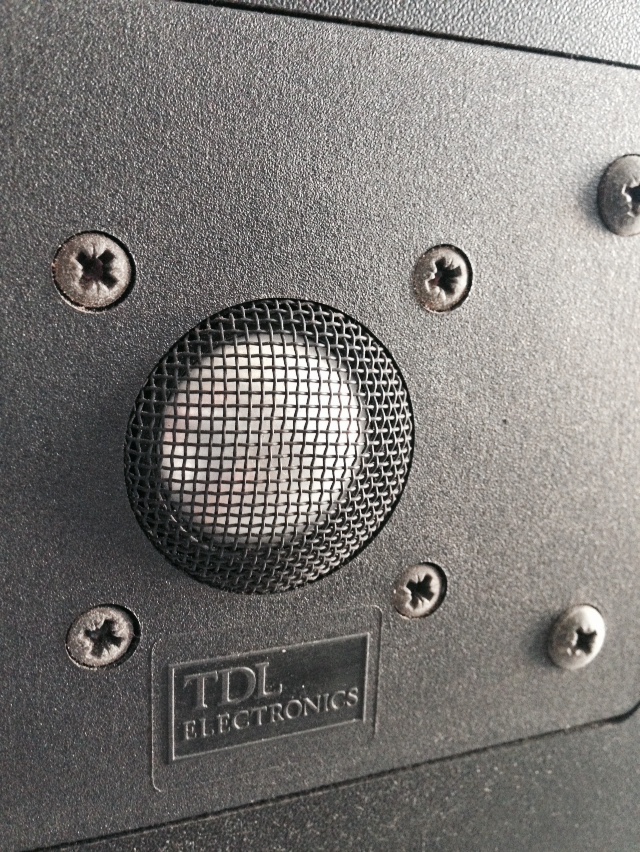
Tweeter Elac 25DT 49
“These TDLs do an excellent job in low end reproduction, which is well extended, solid and controlled so to embarrass their competitors while not overlooking the rest of the audible range at the same time. As you would expect form classy loudspeakers, they have the fundamental gift of neutrality, they don’t add much to the musical information. The top and bottom ends of the audible range are not emphasized but simply naturally presented; the lower end in particular is there for real, present, firm, never exaggerated or pumped up”. It is more than 20 years that the TDL Studio 0.5 follow me in my frequent relocations, in different listening rooms, amazing me each time even if I let them do their job without sitting down to appreciate the spatial reconstruction they are capable of.
Future possibilities
It won’t be easy to part from my small transmission lines. Today there are more modern loudspeakers using different technologies than the transmission line with a bass performance of complete dignity. There are Italian models like the Indiana Line Musa or Tesi, with a very high quality/price ratio. The much more expensive (but maybe more appropriate) English-made ProAc Studio 150 or the American-made Thiel CS 1.2 or CS 1.5 (although from the 90s). The Italian Aliante CNM Tower, Opera Seconda, or much refined Sonus Faber Toy Tower would be attractive as well. Who knows, maybe I would love a pair of Klypsch towers… Otherwise, in order to stay with transmission line technology, a good choice would be the one proposed by the English manufacturer Ival Leslie: his IPL DIY loudspeaker kits are incredibly cheap although inspired to the TDL projects.
That could be a solution if problems of aging would arise, since they say once you’ve heard transmission line loudspeakers you can’t be satisfied by other stuff… In a few words, you get the impression you’re listening to gigantic loudspeakers.
Sometimes I’m taken by the upgrading fever, mainly driven by the fear the loudspeakers date back to 1991 and age could create some problems for my Studio 0.5. I’ve been really close to swap them a couple of times, more for decluttering reasons, since I don’t use the system like in the past. But I just couldn’t do it. How could I be satisfied with the limited frequency response of even very good small speakers? I would also be forced to place them in a bookshelf, with all the issues of the case. So I believe I’ll keep the Studio 0.5 as long as they will endure the impact of time; if aging will claim those almost vintage Studio 0.5, I feel the most natural substitutes will be the IPLs by Ivan Leslie, like the M1tlm Ribbon in the picture above.
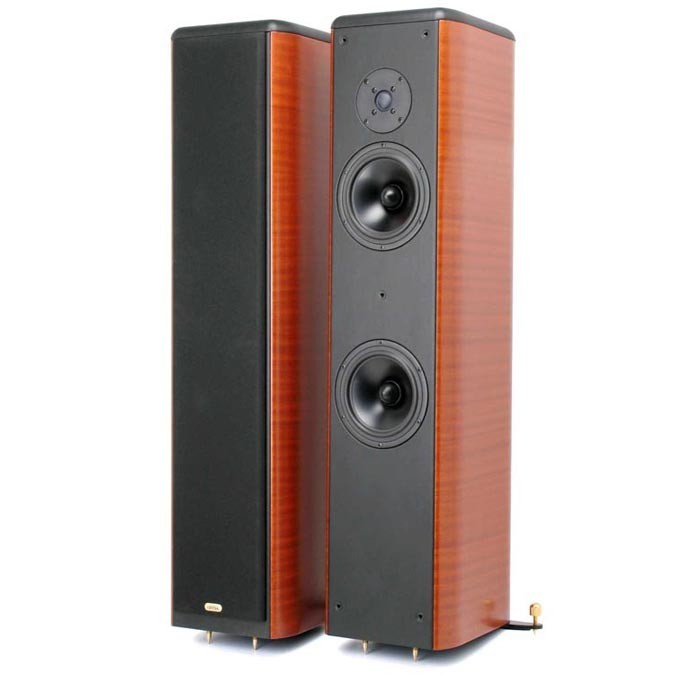 I could also change philosophy completely for a very refined Italian project based on a closed box: the Opera Seconda (the 2006 version in the picture above), now maybe affordable enough used. As the bigger sisters Gran Mezza, they’re capable of a very good low end. They also are small, extremely well built towers (around 1 m high).
I could also change philosophy completely for a very refined Italian project based on a closed box: the Opera Seconda (the 2006 version in the picture above), now maybe affordable enough used. As the bigger sisters Gran Mezza, they’re capable of a very good low end. They also are small, extremely well built towers (around 1 m high).
Lately, I’ve been intrigued and interested in full-range loudspeaker systems with a single cone rear loaded with a horn: the cabinet has an internal labyrinth much like the transmission line – but with different design principles. The full-range speaker cone is interesting in its not needing a crossover filter. Plus, the horn cabinet allows for very deep bass, too. The clean and coherent sound of single speakers are unreachable with classical bass-reflex or transmission line loading with woofer and tweeter separated by a crossover.

If I came to decide for this kind of loudspeaker system I should tackle a do-it-yourself project, namely the one suggested by Chris Templer of TNT-Audio: it is a slightly modified Coral Beta 10 project, with a taller cabinet and different loudspeakers: the Tannoy Monitor Gold 12″. According to Chris Templer, those Tannoys’ sound is “far from the thin anemic efforts of say, Lowther and Fostex type drivers in rear loaded horns” (of which I have read flattering reviews by the way). The low range would also be largely sufficient, as they can easily get as low as 32 Hz. I think I’d like them…
Read more:
TDL Studio 0.5 review on hometheaterreview.com.
TDL Studio 0.5 on witchdoctor.co.nz
TDL Loudspeakers website.
Elac Drivers used in IMF/TDL loudspeahers
IPL Acoustics website, selling cheap transmission line DIY loudspeakers; a review on tnt-audio.com
